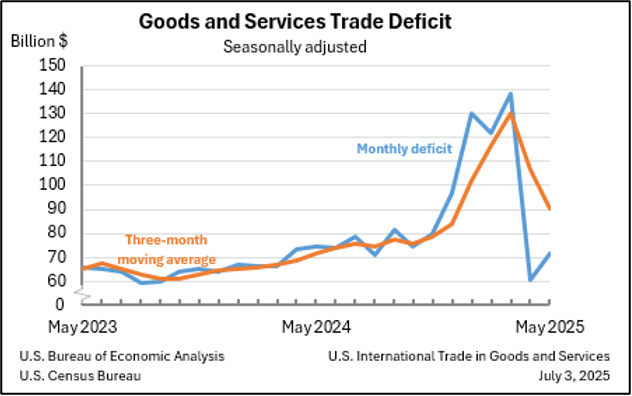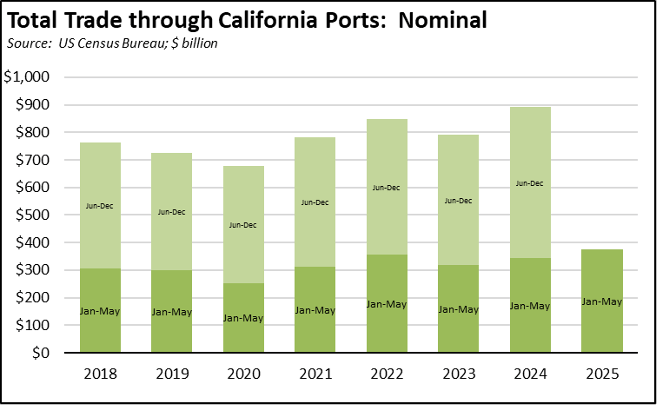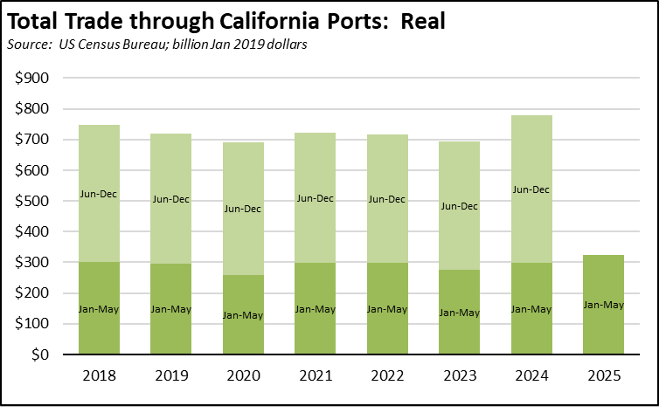Below are highlights from the recently released trade data from the US Census Bureau and US Bureau of Economic Analysis. To view additional data and analysis related to the California economy visit our website at www.centerforjobs.org/ca.
The trade statistics in May once again reflect more shifts in policy around tariffs rather than economic fundamentals. Nationally, the trade deficit rose over the previous month as exports slowed more than imports, but imports remained well below recent months due to the steep variations in pre-tariff surges.

For California, trade through the state’s ports saw reduced activity, with total trade down $2.9 billion (-3.8%) from May 2024 and down $0.9 billion (-1.2%) from April 2025. Year-to-date numbers still show improvements over prior years in both nominal and real terms, but again primarily due to the trade surges at the beginning of the year and recent activity as shippers moved cargo ahead of the previous July 9 deadline for trade agreements. The effects on cargo shipments moving forward remain uncertain particularly since the current round of negotiations with the EU and Asian countries focus on both overall trade levels as well as transshipments and content from China, as in the recent agreement with Vietnam.


As we have discussed in the past, trade levels through the state are an important source of jobs, both through direct trade jobs along with jobs supported by the production of exports and use of imported components and materials. For example, although these jobs are now declining, the Los Angeles Region still remains the country’s leading manufacturing center and it remains in the position due in no small part to the presence of the ports and their ready access to production supplies and export markets.
Tariffs, however, are not the only factor affecting these job levels. Actions by both the state and local agencies continue to raise the costs of using the state’s ports, including actions that threaten to place artificial caps on overall trade activity. The state’s ports are already disadvantaged by higher costs relative to the rest of the US. Our recent study of the Ports of Los Angeles and Long Beach cited previous studies showing the cost of using those ports for discretionary cargo compared to shipping through the Panama Canal ranged from $60 to about $1,000 per container depending on the destination. While the time savings by shipping through California can offset these costs in many cases, it does not in all, as shown by the increasing shift of this discretionary cargo to the other states.
And these costs are rising. While the current tariff uncertainty has provided another opportunity to blame California’s economic problems on yet another “Trump effect,” the state’s own actions are having a more fundamental detrimental effect on both competitive costs and the infrastructure required to support trade jobs. These include:
- Indirect source proposals by South Coast and potentially San Diego air districts.
- Air Resources Board Clean Truck requirements as they may be modified under the governor’s executive order launching ACC III.
- Air Board’s At-Berth rules.
- AB 98 (2024) restrictions on new warehouses.
- Repeated litigation by the Attorney General on new warehouse construction.
- Distribution centers are specifically removed from the CEQA reforms recently enacted in SB 131, even though this infrastructure is critical to overall trade jobs, the only growth industry in recent years for jobs attaining the goals of the “abundance agenda” especially through the provision of middle-class wage jobs to workers with a high school education or less.
California Goods Exports
in Exports
Total California origin goods exports rose $0.6 billion from May 2024 (up 4%). California remained in 2nd place with 8.97% of all US goods exports (12 month moving total), behind Texas at 21.56%.
California Goods Imports
in Imports
Total California destination goods imports dropped $2.3 billion from May 2024 (down -5.6%).
Top 20 Exports, April 2025
Top 20 exports by value are shown below, along with the change from Apr 2024.
